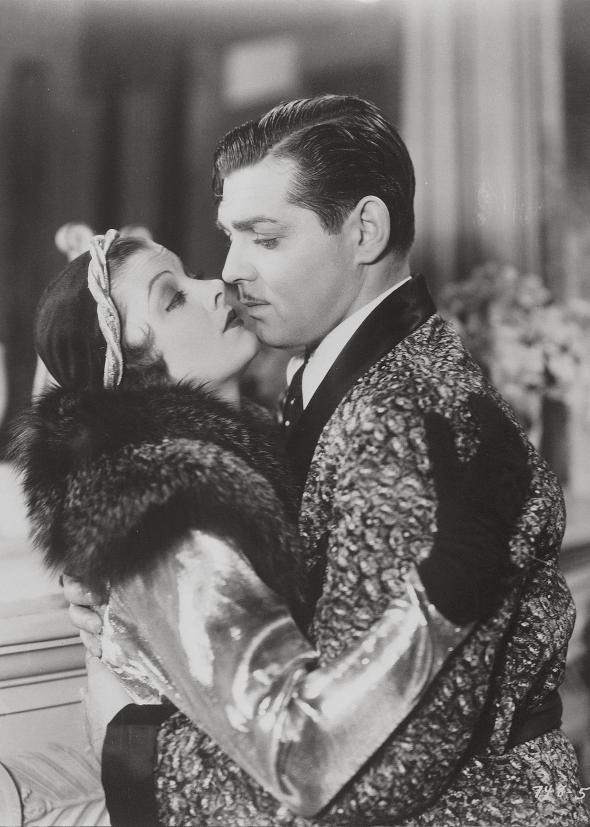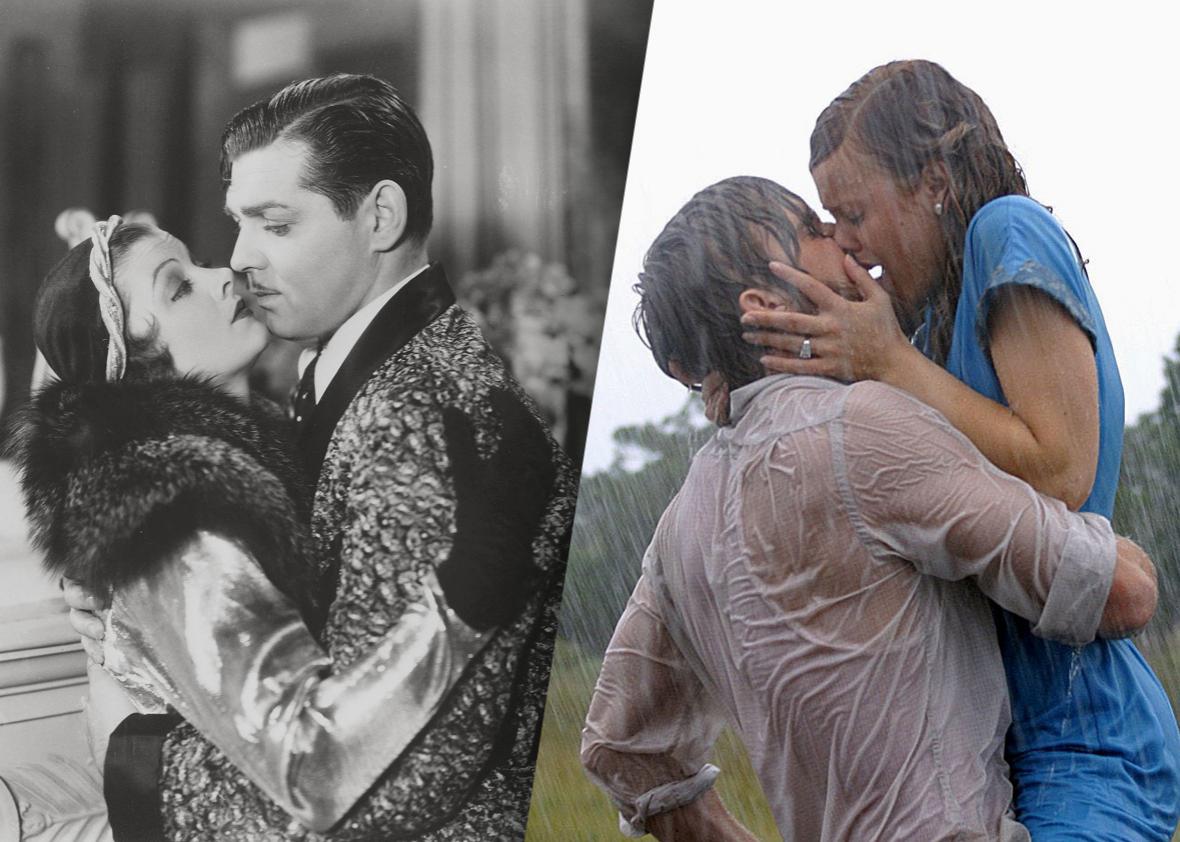In 1911, a stick of gum came with this handy guide to kissing a girl. It offers some useful tips there, such as “do not tell her your intentions” and “look dreamily into her eyes.”* There was an expected response from her too, though the authors hedged their bets with “probably,” in “she will probably drop her eyes and blush when you say that.” They are allowing at least the possibility that she wouldn’t—and the outside chance she’d say, “Move along buster, I have a train to catch.”
The method suggested there is in line with our idea of a young fellow pitching woo at a Gibson Girl. It reflects the gender politics of the day, with the man in charge and a warning about the kind of gal who doesn’t use antiseptic gum. (Although the marketers obviously expected women to buy the product, they don’t seem to have offered a distaff version of this guide.)
But prescriptions for how to kiss continued through the 20th century—with the focus not on how you or your partner should feel, but on how it should look to observers. Popular photography emerged at the start of the 20th century, just as public displays of affection were becoming more accepted. And as photography progressed, Kodak made snapshots available to everyone, and people became more conscious of posing for pictures while taking part in activities beyond simple portraits. In tandem with this, print media and film offered models for how to appear in photos. More importantly, photography allowed us to see ourselves, to be observers after the fact of our own public displays of affection.
Pictures and film have created all sorts of expectations about kissing and intimacy. But the ideals presented have also evolved. In silent movies of the 1920s, kissing often looked rather clumsy, and in a quaint way more believable. Elbows block the view, shoulders hunch, clothing is rumpled.
However, by the mid-1930s, Hollywood offered more stylized versions of the lip-lock. These kisses often featured the woman’s head tipped back at a neck-cricking angle, making both faces visible in cinematic close-up. The woman tilting her head back also served to demonstrate (or at least offer the illusion) that the man was much taller than her—a persistent element in romantic iconography.

ZUMA Press/Alamy Stock Photo
In 1942, Life magazine even offered a guide to kissing for actors on stage (something of a niche topic for a general readership magazine), which was surely also a guide for teens on how not to look like a klutz (“juvenile”) or a slut (“sprawling” on the sofa) in a romantic moment.
The description of “How to Kiss Correctly” makes it very clear there are ways to do it wrong—and their wrongness relates entirely to appearance, not the comfort or desire of the two people involved.
But Life didn’t offer tips on how to do the expert-level photographic kiss: the dip. The most famous of these is probably the V-J Day photo of a sailor kissing a nurse in Times Square. The dip symbolizes male dominance and female submission, but also incorporates a technique of popular dance styles of the 1930s and ’40s (balancing the weight of an adult human requires practice). More importantly, it is an image for an audience. The pose is a display. That exuberant sailor could hardly have known he was creating one of the iconic images of the 20th century. But he was doing something dramatic, a grand public gesture. Kissing a stranger he’d caught off guard, and in so doing showing that this wasn’t just a Hollywood thing: Real people in the street actually kissed like that.
It’s a show of male strength and dominance, perfectly suited to midcentury ideals of masculinity.
But almost as quickly as it became fashionable, the dip kiss disappeared from movies, though lived on a bit longer in sitcoms. Today it seems to survive only in wedding photos, in which couples want to demonstrate a level of romance that is rarely seen in daily life.
In movies, the dip was quickly replaced by another fashionable posture: the standing kiss where the woman bends one leg at the knee, lifting her foot behind her. Artfully lifted feet began to appear in movies before World War II, but the practice really came into its own in the 1950s. It’s a strange pose, and some people think it’s about the woman maintaining balance. However, it’s not something that appears in illustrations (or descriptions) of kissing until the 20th century, and then predominantly in America, so I think it’s safe to assume it’s a recent invention. I suspect it might have started as a method for directors to make fun of the Motion Picture Production Code, enforced from 1934, which specified one foot must be on the ground in romantic scenes.
But the coy affectation of a leg raise also disappeared once movies started to show intimacy more explicitly. (The Production Code was abandoned in 1968 and replaced with the ratings system we know today.) In the 1970s, this meant even PG-rated movies started showing actors kissing with tongue.

Photos 12/Alamy Stock Photo
This “soul kiss” is now regularly parodied—perhaps because we prefer our romance with a dose of irony.
By the 1980s, movies were showing a mutuality in kissing that didn’t depend as much on masculine dominance. But there were also some guidelines for how to make it look good.
In this scene from Some Kind of Wonderful (1987), Mary Stuart Masterson gives Eric Stoltz a master class in kissing (and shows the rest of us how to look cool in fingerless gloves). She tells him bluntly that there is only one “correct” way for him to kiss the girl of his dreams, and anything else will mark him a loser.
More recently, romantic movies have emphasized that love is oblivious to the elements by showcasing lots of kissing in the rain. This isn’t new—it featured in Breakfast at Tiffany’s—but since 2000 has become epidemic, appearing in, The Notebook, Match Point, and Spider-Man (bonus points for being upside down!). Maybe after a century of kissing in front of cameras, we’ve just run out of ideas.

AF archive/Alamy Stock Photo
All of these tropes, from the dip to the lip-lock-in-a-downpour, have become part of our visual vernacular; they are how popular culture models intimacy. Looking at how kissing has been presented in mass media, we can see that it has evolved over the 20th century, from prioritizing the experience of the man to expressing mutuality, to parodies hinting at our own ambivalence about the “happily ever after” scenario.
Kissing changed in the photographic age, becoming a spectator activity, and the bodily postures reflect this. When we see others kiss, we are catching a glimpse of a private intimacy. But kissing for a photo, or in public, is making that intimacy a public event.
Today, anyone can invite spectators to their most intimate moments, posting the images online. At any tourist destination, you can see couples engaging in selfie-stick kisses, which feature an awkward embrace with the eye toward the hovering smartphone, self-consciously enacting rather than feeling. But to judge from Instagram, perhaps the most practiced kiss for the camera today is the duck-face selfie. Posers are puckering up for their own reflections, or an imagined lover on the other side of the screen. A selfie-kiss in the mirror allows people to look dreamily into their own eyes and sigh, and keep the moment forever.
*Correction, Feb. 12, 2016: Due to an editing error, this piece originally misstated the date of a guide to kissing that came with a stick of gum. It was 1911, not 1901.
